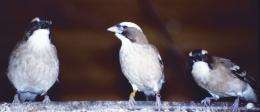A dominant pair of white-browed sparrow weavers (Plocepasser mahali) with a subdominant male (right). Credit: MPI for Ornithology
(PhysOrg.com) -- The brains of all vertebrates display gender-related differences. In songbirds, for example, the size of the brain areas that control their singing behaviour could be linked to the size of their song repertoires. In many songbird species, only the males sing and indeed, they do have larger song control areas in the brain than females. However, even species where both sexes sing identically, display the same sex differences in their brain structure. Researchers at the Max Planck Institute for Ornithology in Seewiesen have now demonstrated for the first time in the white-browed sparrow weaver, an African songbird, that the extent of these sex differences in the brain varies according to social status, and cannot be explained by singing behaviour as previously thought (PLoS One, 8 June 2011).
The white-browed sparrow weaver is very common in eastern Africa. These weaver birds live in groups of up to ten individuals with a pronounced dominance hierarchy, in which only the dominant pair reproduces. They are often heard singing a rapid succession of alternating notes, which both sexes can sing, known as duets. Whereas all members of the group sing the rather short duet song, which can develop into a veritable chorus performance when several singers are involved; the dominant male additionally sings a long and complex solo song that it only performs at dawn during the breeding season.
Neurobiologists have long been interested in how these sex differences in song behaviour are reflected in the birds’ brains. According to the hitherto accepted hypothesis, the structural sex differences in the brains are largest in species in which singing behaviour also varies significantly between males and females or in which only the males sing. “With the white-browed sparrow weaver, we were able to examine in the same species sex differences between two sets of birds, those that sing differently, namely the dominant males and females, and those that sing identically, namely the subordinate males and females”, says Manfred Gahr from the Max Planck Institute for Ornithology in Seewiesen.
The results of the study took the scientists by surprise, as the sex difference they observed turned out to vary with the social status of the birds. The researchers initially found what they expected based on the traditional hypothesis – the dominant males had a far larger song nucleus HVC, which was three times the size of that in the females. However, when they compared the subordinate males and females, both of which sing the same duet song, the male HVC was still twice as big as the female HVC. Another brain area, the RA nucleus, which is also responsible for the production of the song, displayed the same pattern. The size differences are mainly due to the higher number of neurons found in these brain areas. Interestingly, no differences were observed in area X, a region of the brain that plays a role in song learning.
An entirely different picture emerged, however, from examination of the gene activity in the HVC. The activity patterns of two genes that code for synapse proteins proved to be far better correlated with the birds’ polymorphic song behaviour than the size of their brain areas. When they compared the gene activity patterns in the subordinate males and females, the scientists discovered equal levels of activity for both sexes. However, in dominant females, both genes were markedly more active than in the dominant males.
The findings of the various male-female comparisons do not coincide with the accepted view of the regulation of sex differences in the brain and behaviour. If it is assumed that the greater number of neurons found in the brain of the dominant males is necessary for the singing of the complex solo song, then the sex difference in the brains of the subordinate males and females cannot be explained. Alternatively, it is possible that the determining factor here is not the brain area size, but the varying gene activity. “This would mean, however, that once a male has climbed to the top of the hierarchy, it produces the duet song with neurons that show different gene activity than those of the females and subdominant males,” says Cornelia Voigt.
More information: Cornelia Voigt, Manfred Gahr, Social status affects the degree of sex difference in the songbird brain, PLoS One, 8 June 2011
Provided by Max-Planck-Gesellschaft



















